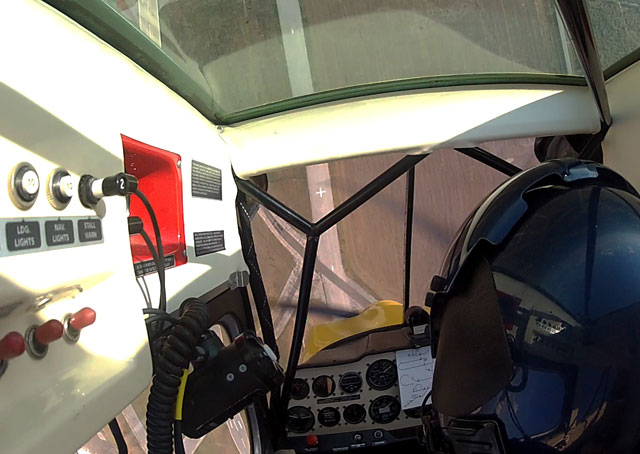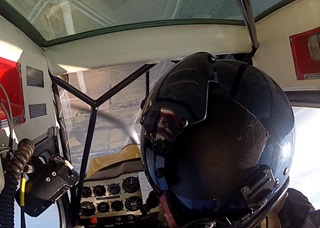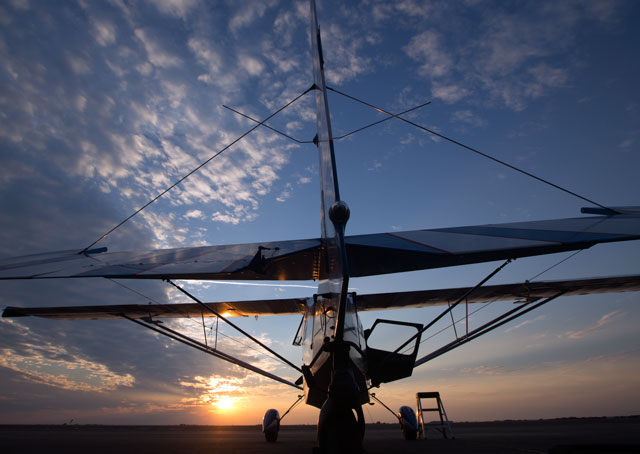
Even in shade, the Texas sun seeps in and saps the mind, particularly a mind like mine, accustomed as I am to cooler climates. As the line moved toward my spot with excruciating slowness, I doused myself with a bottle of water from the ice chest, soaking shirt and even socks, my thoughts seeming to clarify as the cool soaked in and a light breeze hastened evaporation. As it turned out, that only goes so far.
Gary DeBaun, the contest director at the U.S. National Aerobatic Championships, called the Sportsman and Primary pilots together in the morning after the Intermediate briefing, and gave us the options. It was Sept. 24, and time was running short. All flights would end the following day. There was precious little room for us in a busy schedule with flights still to be made in the higher categories. There were no good options to give the 35 pilots flying the Sportsman and Primary categories (in gliders and powered aircraft) a third flight. DeBaun explained that one option was to wrap it with two flights, another was to have everyone fly a second time followed by a third flight only for those in the top half of the standings. That would mean huge point losses for those in the bottom half who were participating in a regional series, since the computer would treat that missing third flight as a big, fat zero, dragging down the average.
One among us offered another option: Have everyone fly the sequence twice in the same flight, giving everyone a second and third chance at a score, working the gliders into the mix. DeBaun asked for a show of hands in support, and from where I sat it looked unanimous. It might be unprecedented, he said, but let’s do it anyway.
Little did any of us know just how long that would take. It was about 7:20 a.m., daybreak, and the flights would still be cycling when the sun set and the tower closed nearly 12 hours later. (Intermediate pilots got their final flight in by roughly 11 a.m., but it was still nearly an eight-hour day on the judging line for those poor souls below who gave us our scores.)
Welcome to the aerobatic enduro, I said wryly to a fellow pilot. At least we’d get a third flight.
The lucky ones were at the top of the order, able to fly before the midday heat truly soaked their heads, though a single flight with two sequences was no picnic, even for the lunch hour crowd. I rolled my rented Super Decathlon to the “18” painted on the ramp, and ran for the shade. Actually, I walked, but with purpose. There was little to do now but wait, and make regular trips to the ice chest for a fresh bottle of water. Find the snacks, run through the sequence. Try to focus.
It was a marathon day. DeBaun, indefatigably cheerful and possessed of a relentless can-do spirit, may have come to question what he had wrought as the hours passed with a slow progression of flights. The Super Decathlons (about a third of the field) needed about four minutes after the first sequence to climb back to the starting altitude; some took longer breaks than that. The pace slowed as the sun marched across the sky. It was what it was, the least-worst option: pushing two flights together.
Restless, I took a seat in the shade under the wing as the last four airplanes in front of me began to launch. I did not fully appreciate at the time the toll all this was taking on my mental state, until I attempted to start the airplane with the mags still off. I silently hoped that would be my last mistake of the afternoon, now past 5 p.m., but there would, in fact, be more to come.
Diving into the box for the first sequence, I had failed to notice a shift in wind that put a quartering tailwind down the supposedly upwind entry, and made matters worse waiting a half-second or so longer than needed to pull vertical for figure one, the humpty bump (two vertical lines capped by a half loop). By the time I hit the downline and saw the center box marker disappear below the nose, I knew I was in trouble: There was no space left to complete the reverse wedge (also called a Shark’s Tooth) before blowing through the south boundary line. A needless waste of points. Try to put that aside and focus on the next figure, the next line, the next thing coming.

One of the judges noted that on figure seven, the basic, plain-vanilla loop, I “ran out of steam” at the top. I was out of steam between the ears, too. I barreled the two-point roll (a slow roll that hesitates at inverted), and kicked myself as I climbed.
Pick one thing to fix, I thought to myself, instructed to climb in the box and advise the chief judge when ready. Circling over North Texas Regional Airport–Perrin Field, I made a mental note to give myself a little more space, make the base leg somewhat wider. And try to fly a bigger Reverse Half-Cuban, build a little more speed for the loop that followed. That was two things, and, as it turned out, a bit much.
Now I was feeling rushed, and struggled to control that. I lined up for a slightly wider (I thought) base leg, told the chief judge I was coming back in, and quickly found myself in roughly the same place I had been in the first attempt: too far south in the box, running out of space. Spitting out an expletive, I pressed forward.
This time through, the spin failed me. Figure four, the one-and-a-quarter-turn spin, had been consistently solid on the two previous attempts, earning (FairPlay adjusted) average scores of 8.1 and 8.3. My frazzled brain made the opposite rudder kick early, and I yelled a fresh expletive, slightly louder, as I aileroned my way to the correct heading, about 15 degrees away, assuming this would be spotted below. It could have, probably should have, been a zero, but by now the judges were pretty tired, too.
A sense of peace comes over a competition pilot as the realization sinks in that the contest has been lost, at least in terms of standings. These were good pilots, at least a few having competed for years at this level. This back-to-back flight, this Texas twofer, was not going to end where I had hoped.
Landing the airplane fully intact was a step in the right direction. Over the next hours, I would find more silver linings, consolation from fellow pilots helping to improve my mood. I had completed three flights at the national championship contest, with no wrong turns, no huge mistakes. Robbie Sturm, who owns a fixed-base operation in Oregon and spent the week running volunteers, including myself, to and from the boundaries, said mine was a “beautiful” flight. I argued the point, but she was undeterred. It looked “graceful,” she said. Super Decathlons lack the energy of a high-performance aircraft, but they can cut a graceful line.
Wes Liu, my friend from IAC Chapter 35, noted that the sting of failing to reach a goal (a top-10 finish, in my case) will fade soon enough, though “the credit card bills will keep coming.”
I didn’t actually collect my score sheets until the following day, Sept. 25, the last day of contest flights. I found some pleasant surprises. For one, I qualified for an International Aerobatic Club Stars award, based on completing all three flights with a minimum grade of 5.0 on every figure. I’ll be sending that application in forthwith. And the contest itself was a personal best, both for an individual flight (my first) and the overall score. Even with 45 points in boundary penalties deducted, I managed 3,000.14 total points after three flights, 73.53 percent of the potential total, averaging just over 1,000 for each flight. I am told that’s not a bad number, a threshold that denotes some basic competence. Even though you’ll find my name pretty far down on the results list, it’s my best total contest score to date, flown under challenging circumstances—a long, hot day in the Texas heat, followed by a double dose of aerobatics.
I’ll take it. Progress to build on. Maybe next year, I’ll even fly that free program I designed so long ago, but never had a chance to practice enough to fly with confidence.
On Sept. 26, the contest over and pilots scattering fast to the four winds, I found DeBaun in the hangar, rooting through his pickup truck in search of a missing radio, one of the 10,000 details he had to juggle as 99 pilots flew more than 300 contest flights in six days, all needing teams of judges, assistants and recorders, starters and runners, tow pilots (himself among them), and chests full of bottled water and ice to be in the right place, on time. You have to admire the logistics. I thanked him for giving us Sportsman pilots three flights, after all.
“Did you have a good time?” he asked.
“I did.”
“That’s all that counts, bud.”




